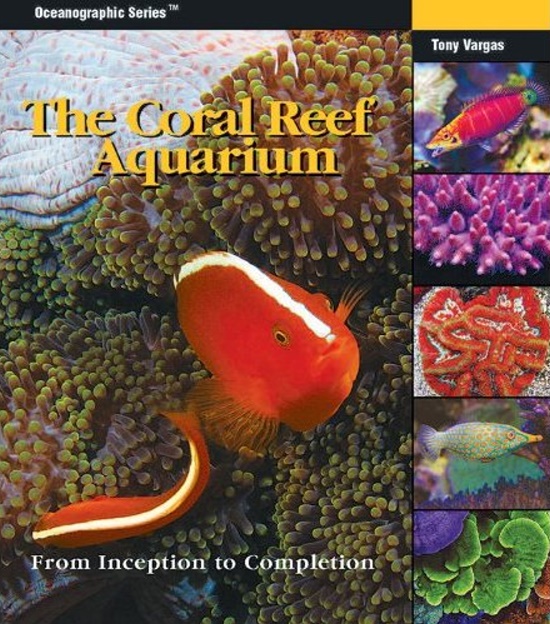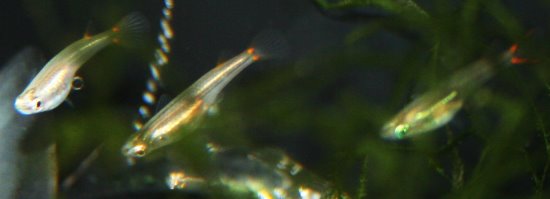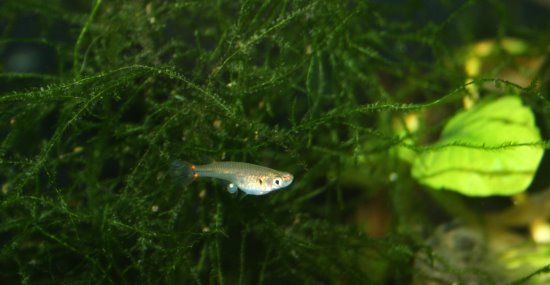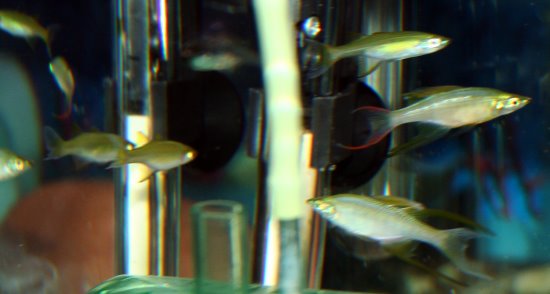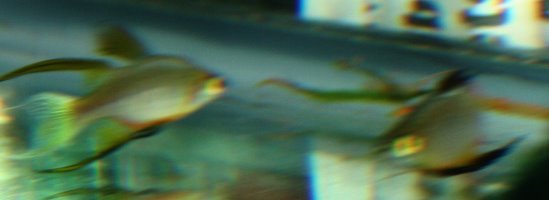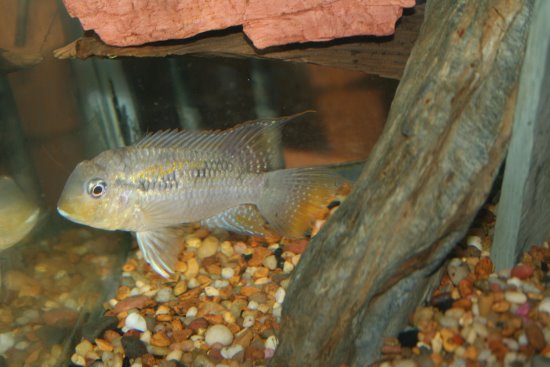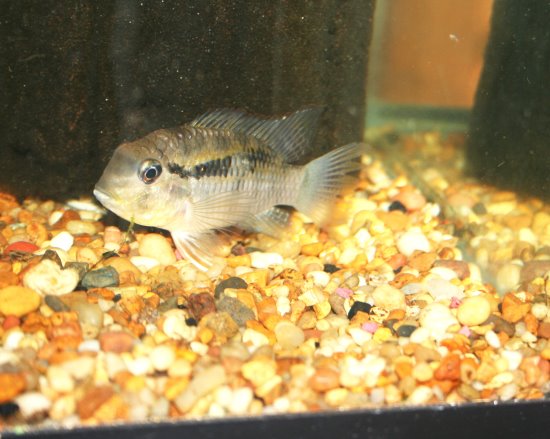This is another reason why you should never release your aquarium fish into the wild.
What’s In A Name? Much Confusion! by Joseph Graffagnino
What’s In A Name? Much Confusion! by Joseph Graffagnino
As Chairperson of the Breeders Award Program, I must research fish species to determine that the hobbyist who has bred that particular species, registers all of the particulars of that species onto the breeder form, accurately and truthfully. On rare occasions I must question the breeder regarding the spawning behavior or the environment or the aquarium parameters of that species if what the person has written is beyond the normal parameters of that particular species’ requirements. In almost all cases the hobbyist has rendered the information truthfully and accurately because many species can and do spawn outside of the range the “experts” list for them.
I use a multitude of methods to determine the accuracy of what the person applies to the breeder form. During the fish fry witnessing, I need to verify that the species is indeed the one supported by photographs or drawings. I use several research books such as Baensch Atlases on tropical fish, Tropical Fish Hobbyist research books on various species and also aquarium related books on particular geographic areas and their endemic species. I also make generous use of the World Wide Web, searching aquatic fish sites, international club sites, such as Planet Catfish, American Cichlid Association, American Livebearer Association, American Killifish Association, International Betta Congress; the list goes on and on.
I believe that I have all of this finally under control when the powers that be decide to change the names of fish species. Some of the experts say that the reason for the name changes is to better align groups into families based on the species’ fins, teeth and jaw bones and/or skeletal body bones. Others say the reason was to sell books with the updated species names. Any way you look at it, when one researches the fish presented, it is a nightmare to verify it wasn’t presented before.
As an example; I found a very nice Central American cichlid that goes under the name Cryptoheros myrnae. The fish were in a plastic bag and obviously stressed, so the coloration and close inspection would have to wait until they were home and acclimated to an aquarium prepared for cichlids. Through trial and error, I had tried to breed these fish. My error was trying to breed them in a gravel-free tank. After I moved several members that weren’t breeding into another tank, I noticed the relocated fish were digging in the gravel and moving it to clear an area near the cave they wanted to spawn in. Aha! So that was a little secret they shared with me.
No problem. I added gravel and kept a pair, or what I believed was a pair, in a separate 10 gallon tank that contained caves. A couple of months went by and viola! a batch of little babies came out of the cave and were guarded and paraded around by mom and dad. Great! Now I wait the required two months before I can register them as being successfully spawned and reared. I look up the species and discover the common name is Topaz cichlid. That name stirs my memory a bit. I check through the voluminous records of the Breeders Program and discover that I had already bred Topaz cichlids five years previous. In those days, they were called Archocentrus myrnae. No credit is given for breeding the same species twice, even though it went through a name change. I was aggravated and wanted to give the fish away at my earliest opportunity so I can clear my aquarium to breed another species.
The next species I want to breed is called Melanochromis Joanjohnsonae Exasperatus, a beautiful African cichlid that goes by the common name of “Pearl of Likoma.” Oh wait, this species also had a name change. It was formally called Labidochromis exasperates. All right, how about Cichlosoma sajica, the “T Bar Cichlid”? Wait! it also changed its name to Cryptoheros sajica- darn it, foiled again!
BAS Event – “Successful Reef Aquariums Around The World” by Tony Vargas, March 9, 2012
This BAS meeting was hosted at the New York Aquarium on March 9, 2012
Title: “Successful Reef Aquariums Around The World” by Tony Vargas
Event Flyer: Download / View Here
[nggallery id=13]
Individuals
Ray Camacho, Anthony Denicola, Michael Gallo, Joe Graffagnino, Joe Magnoli, Kay Martin, Steve Matassa, Joe Morra, Dan Puleo, Charles Ridgeway, Dan Smith, Cap Streeter, Al Turco
Local Stores
Absolutely Fish, Brooklyn Zoo, Fauna, Long Island Aquarium, Mark’s Discus, Pacific Zoo & Aquarium, PetQua, Pet Shanty, Python Products, Royal Aqua World
The Coral Reef Aquarium: “From Inception to Completion” by Tony Vargas
This great book is finaly available for order directly from Amazon. We highly recommend this book to all reefkeepers and those looking to start in saltwater hobby.
Order your copy today!
ORDER HERE >> The Coral Reef Aquarium: From Inception to Completion
As an added bonus you can bring the book to our March 9, 2012 event and ask Tony to sign it for you. You can’t get that anywhere else :)
BAS Event – “Visits To Various City & State Aquaria” by Peter Warny, February 10, 2012
This BAS meeting was hosted at the New York Aquarium on February 10, 2012
Title: “Visits to Various City & State Aquaria” by Peter Warny
Event Flyer: Download / View Here
[nggallery id=11]
Individuals
Bill Amely, Stephen Chen, Walter Chow, John Fox, Demmi Jay Coxe, Gene Kogan, Kay Martin, Steve Matassa, Scott Peters, Dan Pulea, Charles Ridgeway, Mike Roman. Al Tureo
Local Stores
Absolutely Fish, Brooklyn Zoo, Mark’s Discus, Pacific Zoo & Aquarium, Royal Aqua World, Pet Shanty, PetSolutions.com
BAS Event – “Nutrient Control in 20,000 Gallon Reef Tank” by Joe Yaiullo, January 13, 2012
This BAS meeting was hosted at the New York Aquarium on January 13, 2012
Title: “Nutrient Control in 20, 000 Gallon Reef Tank” by Joe Yaiullo
Event Flyer: Download / View Here
[nggallery id=12]
Individuals
Benjamin Basile, Louise Berelstresser, Matt Bronshwag, Nick Caputo, Anthony DeNicola, Bernard Deren, Ray Downs, Joe Graffagnino, Jim Hanna, Gene Kogan, Steve Matassa, Seth Novick, Scott Peters, Dan Puelo, Mike Roman, Roger Schillizi (estate), Robert Stark, Joe Yaiullo
Local Stores
Absolutely Fish, Brooklyn Zoo, Mark’s Discus, Pacific Zoo & Aquarium, Petland Discounts, Petqua, Royal Aqua World
Manufacturers
E.S.V., Long Island Aquarium and Exhibition Center (formerly Antlantis Marine World)
2011 BAS Holiday Party in Pictures. Enjoy!
Our holiday parties are not to be missed; see for yourself.
Photography for this event has been provided by our own member Abid Ikram. Many thanks.
[nggallery id=10]
Black Eggs
“Black Eggs” By Joe Graffagnino
I have bred many species of fish, but I have never seen black eggs. I was amazed when I saw them and from a West African cichlid no less. I obtained a breeding pair of Tilipia snyderea from fellow fish breeder Vinny Babino. Vinny informed me that these are very beautiful fish,with striking color markings. They are aggressive fish when spawning and protecting their young, and they are the gift that continues to give – once they start spawning you can’t get them to stop.
Tilipia snyderea are the smallest of all Tilipia and they hail from Lake Bermin in Cameroon, West Africa. This species’ common name is “Snyder’s dwarf tilapia.” There are three colors that these species can display, based on their mood and especially during breeding. They can go from a pale bland color to a green, to a red. In breeding dress, both the male and female are absolutely stunning with a green top that goes to the middle of their body (lateral line) which extends from the head through the anal fin. The lower portion of the body is an orange red. But that’s not all — the face changes color as the mouth becomes a dark black, while the lips become pure white — truly amazing coloration on a fish that gets no larger than 4 – 5 inches.
When I received this beautiful pair of fish, I realized they were too large for a 20 gallon aquarium, so I quickly did some rearranging and moved them to a 30 gallon wide aquarium. I believe in species tanks so I kept them by themselves. After less than one month in their new home, they started moving large amounts of gravel in the tank. They really like to landscape. Four days after the landscaping began, the female took up residence in a small clay breeding cave that had an opening the size of a thumb. It was obvious that the male could not enter. I assumed that they would lay their eggs on the glass bottom since they made it bare by moving all the gravel away. A day or two later I used a flashlight to see into the cave and lo and behold! I saw around 20 or so black eggs.
A few days later, they must have hatched because the parents moved the fry one foot away from the cave and under a piece of coral. I was worried for the fry because this tank was overrun with Malaysian burrowing snails, who I thought may go for the babies. However, within a few days my snail problem was a problem no more. After their yolk sacs disappeared and the fry started free swimming, I fed them microworms, vinegar eels and frozen baby brine shrimp. The fry grew quickly and they tended to clone each other, for although I initially counted around 20 eggs, I now counted about 80 swimming fry.
I would highly recommend this beautiful, but aggressive West African cichlid as a welcome addition to a species only tank. Also, this fish is on the endangered list of fish species, so maintaining this fish will help it from becoming extinct in the wild. Please share this wonderful fish with other members of local fish clubs and let everyone enjoy them.
Mekong Rice Killies
Mekong Rice Killies By Joe Graffagnino
I was recently at the latest meeting of the Northeast Council of Aquarium Societies in Connecticut and had no intention of purchasing any new fish, since my aquariums were already very well stocked. As I wandered around, I came to Frank Greco’s sales table. Frank has the most interesting and rare fish that you will ever see. I strolled around the table and my eye caught something small flash by. It was a really small fish with a silver body; the male has an orange red coloration on its anal fin. I had to ask, and that, of course, was my undoing.
Frank told me that particular fish was commonly called the Mekong Red Lampeye Rice Killifish. The fish are found in the Mekong River delta in Northern Thailand. The adult of this species doesn’t get over ½ inch in size. There are approximately 2 dozen varieties of rice killifish. The nice thing about these fish is they can live and spawn in aquariums as small as 2 gallons. All that is needed is a sponge filter and java moss. Since these fish are really small, frozen baby brine shrimp works well (regular brine shrimp and Daphnia are too large for them). They also thrive on live microworms, vinegar eels and crushed flake food.
When the female is carrying eggs, she carries them on her body. The eggs are slightly adhesive so when the female swims through java moss the egg rubs off the mother and attaches to the java moss. The male fish follows closely behind and fertilizes the egg. At times I have seen one female carrying several eggs. The eggs are quite large for such a small fish and they resemble clear to opaque killie eggs. As the embryo matures, the egg darkens. Within a week the fry are free swimming. The parents ignore the fry so you don’t need another tank to rear the fry to adulthood. You can’t ask for better than that in a fish!
The water parameters are basic with the pH 7.0, GH of 3, and the temperature 78 – 80 degrees Fahrenheit. This is a great and unique little fish and quite prolific once they get started. Because of their small size, I would maintain them in a species only tank. Enjoy them and share them with other hobbyists.
President’s Message – December 2011
Happy Holidays to all our members, family and friends. We have much to be thankful for this past year, such as our celebration of the Society’s 100th Birthday. We have had a great array of guest speakers from seasoned veterans such as Pat Donston of Absolutely Fish and Richard Ross of the Steinhart Aquarium, to new speakers giving their first lecture at BAS such as Joe Caparatta of Manhattan Aquariums and Anthony Stissi of Staten Island Cichlids.com. The Brooklyn Aquarium Society has always been a great place for new and old aquarists. Now marching into our 101 year of existence, the high standards and love for the hobby that was present 100 years ago still exists today. May all of you have a safe, healthy, happy and holy holiday season.
.
2011 also brought sadness to our Society. – Frank Policastro, our longest continuous member, since 1964, has passed away. I am happy and proud that we were able to honor Frank at our 100th Birthday this past July. Frank was not just a member, but he was on the Board of Directors and an Officer for many years in the mid to late1970’s. Frank went on to become a founding member of the Jersey Shore Aquarium Society, as well as Treasurer for the North Jersey Aquarium Society and served on the Board of Directors for the NorthEast Council of Aquarium Societies (NEC). He was very active and extremely dedicated. He was true to himself, his family and to the aquarium hobby. Frank will be greatly missed by everyone.
.
January 2012 brings us our friend Joe Yaiullo, curator and co-founder of Long Island Aquarium & Exhibition Center. To start the new year off properly, Joe’s topic for the evening will be “Eleven Years of Feeding Long Island Aquarium & Exhibition Center’s 20,000 Gallon Reef.”
.
Please visit our new website where you can read the Bulletin and enjoy a full color Aquatica. The interactive forums and sponsor sections are truly enjoyable. Provided you have given us your email address, you will be getting notifications of club events via email.
.
I am asking for your help and support. If you want to see different speakers or try different things, please let me know. The elected officials of the Brooklyn Aquarium Society are here to serve YOU! Please let us know what you want and why. It would be helpful to everyone. A survey of our members has been conducted over the past several months on what you want to see and do as a member – the results will be in the January Bulletin.
.
It is important that you visit and patronize our sponsors. It goes full circle: by helping them, they are also helping you as hobbyists and everyone is helping the Brooklyn Aquarium Society, so help us, help you!
For more info, please call our BAS Hotline at (718) 837-4455.
.
On a more personal note – Any member who desires to attend a Board meeting, which are held at the Education Center of the New York Aquarium on the 1st Friday of the month, please notify me at (718) 238-1792 by the Tuesday previous to the meeting.
Joe Graffagnino
President
Donate Food or Toys, Get Tix to New York Aquarium!
The New York Aquarium is hosting a TOY and FOOD DRIVE during the holiday season.
Contributors will receive a complimentary ticket to the NYA in exchange for donations of new, unwrapped toys or bags of food containing 10 items.
We will be collecting items until 12/31/11
Please click on the below link for details.
THANK YOU!
Threadfin Rainbows
Threadfin Rainbows By Joe Graffagnino
The Latin name for these beautiful fish from New Guinea and northern Australia is Iriatherina werneri. These nervous and sensitive fish thrive in slow moving streams with heavy vegetation. According to the Master Index of Freshwater Fishes, they enjoy a pH of 6.0 – 8.0, with a designated hardness from 5 -12 and a water temperature of 79 – 86 degrees Fahrenheit.
I keep two males and 4 females in a 10 gallon tank, with a corner filter containing charcoal and ammonia chips and one or two artificial yarn spawning mops. They prefer a dark green mop that hangs from a cork or 35mm film canister to almost an inch from the bottom of the tank. I keep no gravel or plants in the tank, only the mop. I have tried either light blue or black yarn mops with little success. With the dark green mop I have been averaging 40 eggs per week. They prefer to lay their eggs between the middle of the mop to the bottom. I pluck the eggs from the mop on a weekly basis moving them to a plastic shoebox where I allow the eggs to hatch with a slight amount of Acriflavine to prevent fungus. In a few days you can see the tiny babies swimming across the top of the plastic box. I then move the fry to a larger plastic box to grow out. These are slow growing fish that need rotifers, artemia or Small Fry Food. After a few weeks, with 3 times a week water changes (only with aged water), they are large enough to take baby brine shrimp.
Water changes are extremely important for this fish to maintain good health. I change the water in a 35 gallon tank next to the Threadfin rainbow fish tank. After the freshwater has been filled in the larger tank, I wait several hours or the next day to take water from that tank to replace water removed during a water change. Using this mixture of new and aged water, there is no stress on the parents or fry. I feed the adults live or frozen brine shrimp and cyclopeeze, because their mouths are small, twice daily and perform weekly water changes of 20%, as outlined above, in the adults’ aquarium.
Threadfin rainbows are one of the most beautiful freshwater fish I have ever seen. The females are a silvery color, but the males have long flowing fins of black, red and yellow. The males use a flickering of their fins to attract the females to spawn. If you want to keep an interestingly beautiful fish that will give you hours of enjoyment, then I highly recommend these graceful beauties.
Whiptail Catfish
Whiptail Catfish By Joe Graffagnino
There are several species of Whiptail catfish which are very difficult to distinguish apart. This catfish species comes from cool, fast moving streams in South America. The species Latin name is Rineloricara. This type of catfish gets its common name from its slim, armored, flat, and stiff body that has color variations from gray to brown. They are a slow moving, peaceful fish that has a tail fin that extends to a delicate “whip-like” extension. Whiptail cats get about 6 inches in length. The only way I can sex them is the female’s belly is larger than the male’s, as is with most types of catfish. When the female is pregnant, her stomach is huge; she will sit outside the PVC tube and wait for the male to allow her entrance. As she lays her eggs, he is directly behind her fertilizing them. When completed, the male then chases the female from the tube and he cares for the eggs.
I received my group of a dozen small fish from one of Brooklyn Aquarium Society’s expert fish breeders – Lisa Quilty. Lisa bred the parents in a small PVC tube and brought the fry in for “Breeder Award Points” and she is one of our club’s leading spawners of difficult fish. I brought them home and set the group up in a 10 gallon tank with riverbed gravel, a corner box filter that contained charcoal and ammonia chips and I placed a couple of wood pieces in the tank to make them comfortable. After a few months, I added some small and narrow clay and PVC tubes. The small fish grew quickly with weekly water changes and high protein flake food. To improve their diet, I gave them frozen foods such as blood worms, cyclopeeze and daphnia a couple of times a week. I would, on occasion, provide them with a piece of frozen zucchini that they would ignore until it started getting a fungus on it and then the next day the zucchini would be gone. I guess they will only eat it if it’s soft.
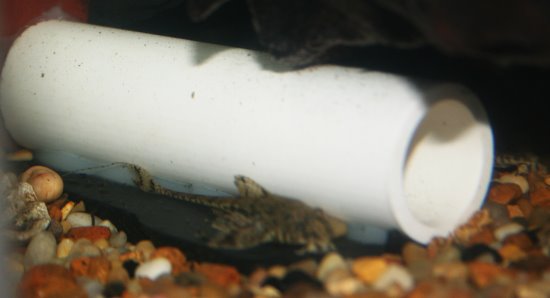
Early one evening, my friend and fellow fish breeder Vinny Babino came over and, as I was showing him the various fish I had in the aquariums, he looked into the whiptail catfish tank which I kept at the end of a long row of tanks that I rarely paid any attention to, and remarked that there appeared to be a lump inside the PVC tube. I looked and then with a flashlight discovered the male was sitting on a batch of green eggs. With this species, the female lays the eggs and the male cares for the eggs, actually gently scraping the eggs to help the fry escape after about 7 days..
An interesting note: Vinny had obtained the parents of the fry and had them in his home aquarium. When he went home that evening, his fish had also laid eggs in a PVC tube. Several times afterward, both of our groups laid eggs the same day.
I must have had my fish for approximately 2 years before they spawned.
When the fry became free swimming, I fed them crushed egg flakes, which help fry grow faster, and some frozen zucchini that they allow to soften before eating it. The fry grow quickly with frequent water changes and heavy aeration. The spawning tubes were 6 – 8 inches long and 1” wide, open on both ends. The GH was 2, pH was 6.3 and the temperature was 76 degrees Fahrenheit. After the first pair spawned a second time, 3 weeks after the first spawn, other pairs started breeding. I guess the pheromones in the water activated the others’ spawn cycle. I found 36 babies from the first spawn; in some spawns the eggs were eaten and in others, when the babies were released, the adult whiptails ate them. The spawns became larger and after several months I counted 84 fry in a single spawn. The fry are small so if I didn’t see them on the glass so I could siphon them up, the adults would go for them. I found that these fish need natural wood in the tank, which I believe helps them digest food.
Never use glass gravel for this species of fish.
I highly recommend this delicate in beauty, yet hardy in nature fish for your aquarium. They are a joy to behold and will not bother other fish or plants in your tank. After you have bred them, don’t forget to bring the fry to your local fish club and share the fun with other hobbyists.
Print, Clip, Save!
It’s really that easy for BAS members. Just print, clip and save.
Water Chemistry: Osmoregulation, Ionic Imbalance & pH by Joe Gargas
Correct Water Chemistry is the single most important subject for the successful keeping and breeding of Tropical Fish. Water is to fish as air is to human’s; it is the environment that they live in, breed in and get old in. The health and well being of our fish is directly related to their physical water environment. As advanced Hobbyists the more we know about Water Chemistry, the more successful we will be as Fish Keepers and Breeders.
Read the whole article in our own Aquatica, starting on page 7
Breeding The Banded Acara (Bujurquina Vittata)
Breeding The Banded Acara (Bujurquina Vittata) by Joe Graffagnino
The Bujurquina vittata is an interesting biparental mouth brooding South American (basically from Brazil, Argentina and Paraguay) cichlid. This little beauty, as it doesn’t grow larger than 4.5 inches, is unique because both parents take the fry in their mouth when they move from foraging locations. If predators are about, the fry zoom into the parents’ mouths and the pair makes a quick escape. The parents were fed a diet of African Attack pellets, various types of flakes and live black worms. There were originally 3 females and a male when I got them from friends at the North Jersey Aquarium Society, hence the need to join several fish clubs. It took several months, but eventually I found the male and one of the females prodding the other two females away. Not wanting to have the single females hurt, I moved them to another aquarium. The new pair quickly set up house in the center of the tank.
They are excellent parents, although they are very nervous, zooming across the aquarium at full speed. Fearing for their safety, I taped newspaper on the front glass. To observe them I had to carefully and quietly move to the side panes. I had to limit water changes for fear of upsetting them with a possibility of them eating their fry. They managed to lay their eggs in the inside of a half of a coconut shell, along the top ridge. However, after a few weeks of semi isolation, I was rewarded when I witnessed a cloud of babies rising off the bottom, in the center of their parents. For the first few days of free swimming, the babies rarely left their parents, but as days wore on, they started venturing further away. The parents were trying to corral them into one spot, but the fry didn’t want to hear it. After the babies were swimming for two weeks, I removed the parents to a separate tank. I kept the parents’ tank unlit so as not to spook them. They were able to see from the lights of other aquariums nearby. The babies didn’t seem to mind the absence of their parents and continued to graze off the algae and bits of food around the tank. I started them on frozen baby brine shrimp and crushed flakes. Regular biweekly water changes of 15% declorinated tap water produced larger fry. The environment the fry lived in was 80 degrees Fahrenheit, neutral pH, soft water as are NYC standards. In a couple of weeks, they moved to frozen cyclopeeze and minced blood worms.
The males have blue lips, with yellow flush cheeks with a gold streak moving horizontal above their lateral line. The males also have a red trim along the top edge of their dorsal fin. Males have lyre tail strings that extend from their dorsal, anal and tail fins. They have turquoise blue lines in their pectoral finnage and are repeated with aquamarine dots in their anal and in the rear of their dorsal fin. The males develop a slight hump on their forehead. The females are slightly smaller and are blander color wise, but still maintain the aqua blue in their anal and at the end of their dorsal fin. They don’t have the extended fins of the male and are a gray in color with slight yellow in their face and cheeks.
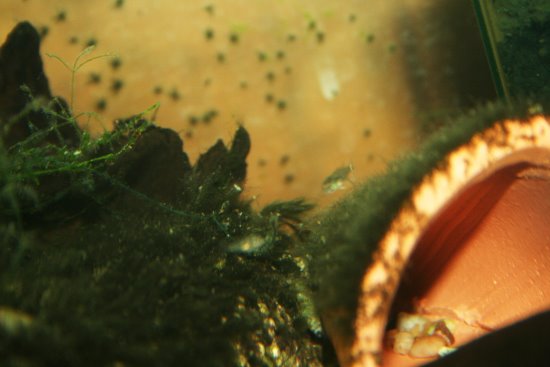
I highly recommend this interesting and pretty fish. Their temperament is mild, they don’t bother tank mates and they eat anything in flake, pellet or frozen form. They do especially love live black worms. I feed them a few pellets or flake and then the live food because it will stay in their stomach longer. This will, in turn, give them greater amounts of protein which produces larger quantities and more fertile eggs. Set them up in a tank of their own, such as a 30 gallon (36”L x 12”w x 20” H) and let them pair off and enjoy their antics.

